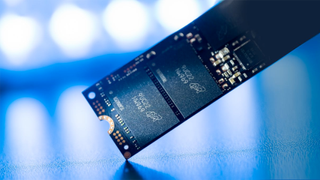Analysts Predict SSD Prices May Halve by Mid-2023
PC storage devices could get cheaper in coming months.

While makers of memory are cutting down their 3D NAND output, the surplus of memory chips and solid-state drives is so significant that their prices will continue to fall for months to come, according to analysts rom Trendfocus via StorageNewletter. In fact, prices of SSDs may drop by two times by mid-2023.
Slowing demand for PCs by consumers as well as some businesses naturally means lower demand for all kinds of computer components, including processors and graphics cards. But commodities like 3D NAND, memory modules, and solid-state drives suffer from dropping demand more than other categories. The key reasons being that they are relatively easy to produce, there are many competitors on the market, and finished goods usually sit in their inventory before getting acquired by PC makers, component producers, or resellers.
In the recent weeks Kioxia said it would reduce production of 3D NAND wafers by 40% starting October 1, whereas Micron said it would slowdown its 232-layer 3D NAND to limit 3D NAND bit supply. It is noteworthy that Micron's 232-layer 3D NAND is meant to enable some of those best SSDs with sequential read/write performance that exceeds 10 GB/s. But such actions are not going to come into effect immediately, analysts from Trendfocus believe as both companies have plenty of 3D NAND in stock, whereas SSD makers have loads of drives in their inventory that they need to sell.
Nowadays one can get a Crucial P3 500GB M.2-2280 drive for $44 at Amazon, which is 8.8 cents per gigabyte. There are even cheaper 2.5-inch PNY CS900 500GB SATA drives that retail for $31, or 6.2 cents per gigabyte. While retail 3D NAND per-bit prices are already low, Trendfocus anticipates flash memory makers to offer nearly 40% to 50% per-bit price declines by mid-2023, which will further reduce costs of SSDs as well as their retail prices.
At present it is hard to estimate how many SSDs are sitting in inventory of dozens of manufacturers, but Trendfocus assumes that it is going to take at least two quarters for cloud companies and PC makers to digest already produced 3D NAND and drives, so expect SSD prices to continue their declines for at least two quarters.
How cheap those SSDs will get is hard to tell at this point, but mainstream drives with a PCIe 3.0 x4 or PCIe 4.0 x4 interface will definitely get cheaper over the next few quarters. Suppliers of premium 3D NAND memory and SSDs with a PCIe 5.0 x4 interface will try to offset their declining revenue with their top-of-the-range drives aimed at enthusiasts, so do not expect those shiny new PCIe Gen5 SSDs to get cheap any time soon. Yet, mainstream SSDs used for bulk storage could get cheap enough to replace some of low-capacity hard drives, it seems.
Stay On the Cutting Edge: Get the Tom's Hardware Newsletter
Get Tom's Hardware's best news and in-depth reviews, straight to your inbox.

Anton Shilov is a Freelance News Writer at Tom’s Hardware US. Over the past couple of decades, he has covered everything from CPUs and GPUs to supercomputers and from modern process technologies and latest fab tools to high-tech industry trends.
-
cyrusfox still waiting for $20 512GB and $40 1tb, Drives like the P31 seem to never drop in priceReply -
George³ Very brave prognosis. :)Reply
I remember promises or prognosis from several years(maybe close to decade) ago that around 2020-2021, prices per gigabyte of SSDs will level off and then fall below those of gigabyte of HDDs. These predictions were for quite a long time ahead and understandably did not come 100% true. Current analysts are worthless after giving estimates for just a few months ahead. They present to us as their forecast things that are completely visible as developments even by people who do not have any professional training for analytics, but simply keep an up-to-date monitoring of the market's price movements. I would not hire such analysts to work for me.
What if they get the percentages wrong again? -
DavidLejdar It would certainly be nice if M.2 SSDs drop in price.Reply
In the long run, I want to go for Gen5 - which is why I am looking to get a new motherboard supporting that (and the few Alder Lake motherboards which have it, these are not an option as they take away PCIe 5.0 lanes from the GPU and are expensive).
But as the PCIe 5.0 SSDs haven't really been released yet, it sure isn't surprising that they will be at premium price for some time. So I am looking at older SSDs to use one as system drive for now (and later as storage drive), and would be nice if there would be more options.
On the other hand, e.g. Crucial P5 Plus M.2 NVMe PCIe 4.0, the cheapest price I see for 1TB, that may still seem expensive when looking at price per gigabyte, but it comes with a lot more speed than what SATA SSDs have. And for me with a modern broadband connection, large storage volume isn't that important, as downloading a GB in less than two minutes makes hoarding data somewhat obsolete when I can download two 100 GB games while I am at work, and so on. -
ravewulf Currently I've got two 2TB NVMe drives (one PCIe 3.0 and one 4.0) and two 6TB HDDs for bulk storage (videos, ISO files, etc). It would be cool to replace one of the HDDs with a 4TB SATA SSD if the prices are low enough (the difference in capacity wouldn't be too bad if I shuffle data around). They've already been trending closer to $300 and I'm hoping to catch a sale around Black Friday/Cyber Monday. If we do actually see the prices drop by half next year I might pick up another.Reply
Most Popular


